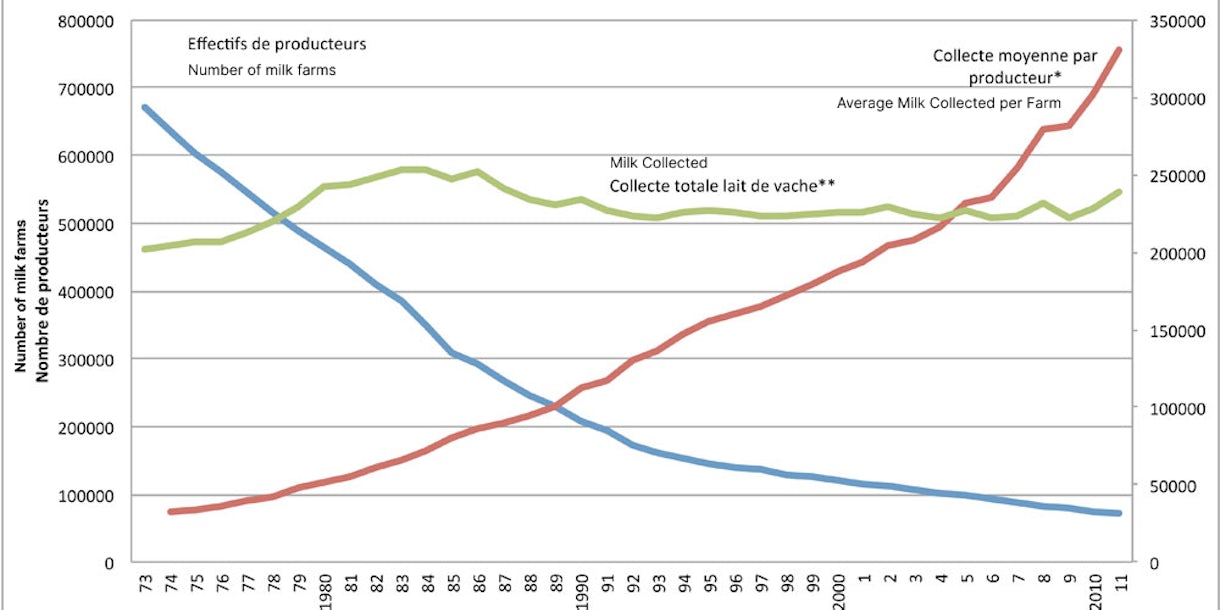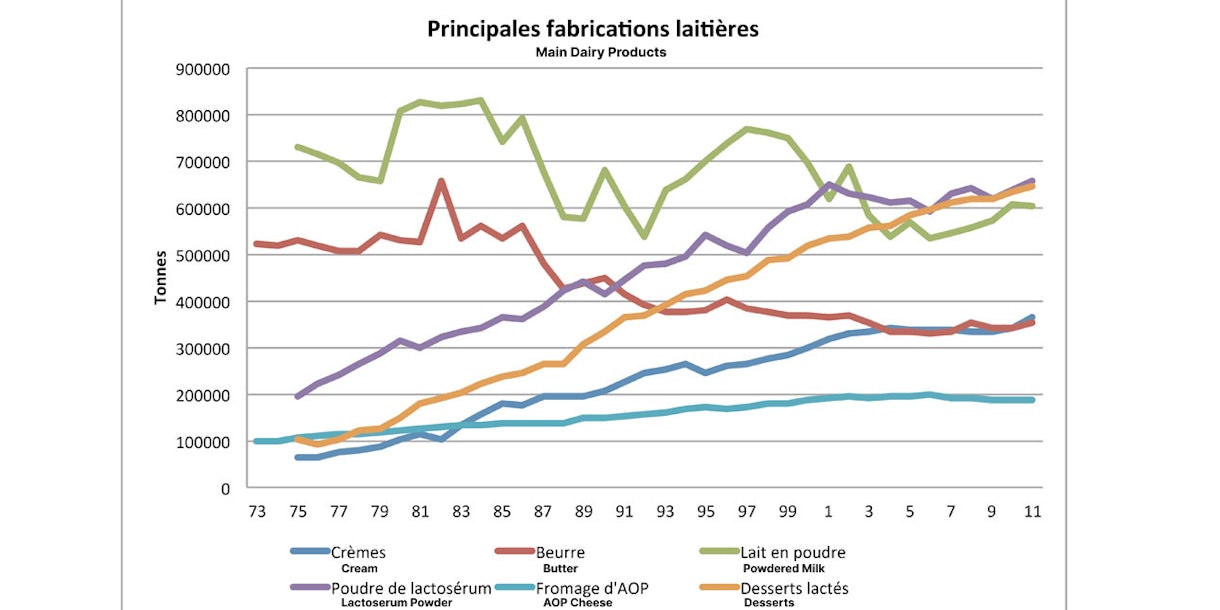Is France running out of Butter?
Or a glimpse into an Industry
The reason? A shortage of “Galette des Rois”, or King’s Cake, a famous traditional cake the French eat for the Epiphany on January 6th. Every year, around 30 million galettes are sold in France. This year, the average price increased by 20%.
In all interviews, bakers were pointing to one culprit: the price of butter.
French cuisine is famous for its heavy use of this magical ingredient, the key to so many recipes, especially pastries. And at the Bow Tie Duck, butter is one of our most beloved products. But since the end of 2021, we’ve been facing difficulties in bringing in butter.
To understand this crisis, we need to go back in time and understand the dairy industry in France.
The Birth of the Modern Milk
Let’s go back to after World War II. France’s main goal was to be able to feed its population, especially with the baby boom, and the reconstruction efforts underway.
The strategy was clear—with proper quality control, and the right incentives to mass produce, milk could become a really affordable source of nutrition, with a great calorie to price ratio.
So, France needed to find ways to increase production; they needed to rationalize agriculture. The industry focused on one cow breed—the Holstein, fed with a highly energetic Maize silage (corn). The Holstein became the posterchild for the typical milk cow, with its black and white pattern. Milking eventually became mechanical, and the usage of artificial insemination quickly became widespread. And the Marshall Plan allowed massive investments into the infrastructures.
The whole system was protected by the EEC (European Economic Community, the ancestor of the EU) in two major ways. The first being that the price of milk was centrally negotiated annually, and the second was the price of milk being insured by financial exports, which allowed some resistance to overproduction.
This resulted in milk production exploding, creating a need to process this huge production. This was the time when new mass dairy products were invented, like the Laughing Cow (yes, it’s French!), BabyBel, and President. This was also the time of innovation, with products like powdered milk and UHT (ultra-heat treated) milk coming out, allowing nationwide and even international distribution. Milk production didn’t have to be local anymore.
Some big companies also started to emerge at this time, among them Lactalis, now the world’s biggest dairy company, with brands like Président, Galbani, Lactel, Bridel, Ambassador, Société and others.
The Crisis and Creation of Quotas
In the 70’s and early 80’s, milk production started to be too high to be manageable by the EEC. Between 1973 and 1983, dairy production in the EEC increased by 2.5% a year, while consumption increased only by 0.5%.
Problems arose. The Eastern bloc imported little but sporadically, emerging economies were still far from being the powerhouses of today, and the United States was already mostly self-sufficient in terms of dairy. International demand was not sufficient to absorb this surplus.
The solution became clear in 1984: artificially limiting the production of milk by setting up quotas. Each year, milk production would have a target per country, and each liter of over-produced milk would be fined.
The consequence was drastic reductions in the number of dairy farms, dropping from 370,000 in 1983 to only 75,854 in 2010.
The price of milk is stabilized at a high level that allowed farmers to live. The European dairy market stayed mostly domestic, but focused on high quality products—especially cheeses and butter, instead of mass production.
At the same time, the quotas reduced the number of farms and created bigger farms while keeping a steady global output to a few big companies that transformed this milk into dairy products, like milk, powdered milk, cheeses, cream, and butter.
The End of Quotas

Evolution of Milk Production and Production per Farm
Remember that the main reason for the quotas was the fact that there was no possible output for European milk surproduction. But in 2015, the situation becomes totally different.
Emerging countries are now key markets for dairy products, with China imports of milk growing steadily, due to a mistrust of the local production.
With the end of quotas, the whole milk market in Europe becomes totally liberal, and the price of milk, instead of being overseen by the EU, is fixed by the market. And as we’ve seen, the market is a few huge dairy companies buying from thousands of farmers who struggle to be barely profitable.
And here we see a paradox. France is the most competitive country for dairy products in the world, but its farmers can barely survive, and start closing en masse.
Today’s Crisis: An Arbitrage
To start with, some numbers:
- In January 2021, one ton of butter was at EUR 3200 / ton.
- In January 2022, one ton of butter was at EUR 6000 / ton.
- This month, it is at more than EUR 7000 / ton.
On one side, we have fewer and fewer farms that are barely profitable, and nobody taking over once the producers retire, which explains a start in the decline of production. Production costs are also exploding right now, with an increase in cost of energy, fertilizer and feeds. Demand is also booming for some dairy products, with an increase of 30% to 40% of the imports of milk powder, and an increase of 19% in butter for China alone, who seem to have increased its reserves.
Basically: more demand worldwide, less production, and higher costs of production.
The industry is faced with a dilemma, and has to make a choice: which product is best to produce in this situation? Here are the choices:
- To make 1kg of butter, you need 22 liters of milk.
- To make 1kg of cheese, you need 10 liters of milk.
- To make 1kg of powdered milk, you need 7 liters of milk.
- To make 1kg of crème fraîche you need 7 liters of milk.
- To make 1kg of yoghurt, you need 1 liter of milk

Main Dairy Products Produced
The industry is using this arbitrage to optimize its revenue:
- For the export market, producing a lot of cheese and powdered milk where the margins are the highest
- For the domestic market, focusing on cheese and yoghurt where margins are great
- Creating a shortage in butter to increase its rarity and its price to maintain high margins, which affects, in the end, all butters—industrial and high end.
And this is why it is becoming harder and harder to find butter, and we see prices sky-rocketing all around. We need to order our butter far in advance to be able to provide it to you, and some brands have stopped accepting new customers and orders.
But this is only one of the food crises we are witnessing this year. The most profound will be explored next week.

